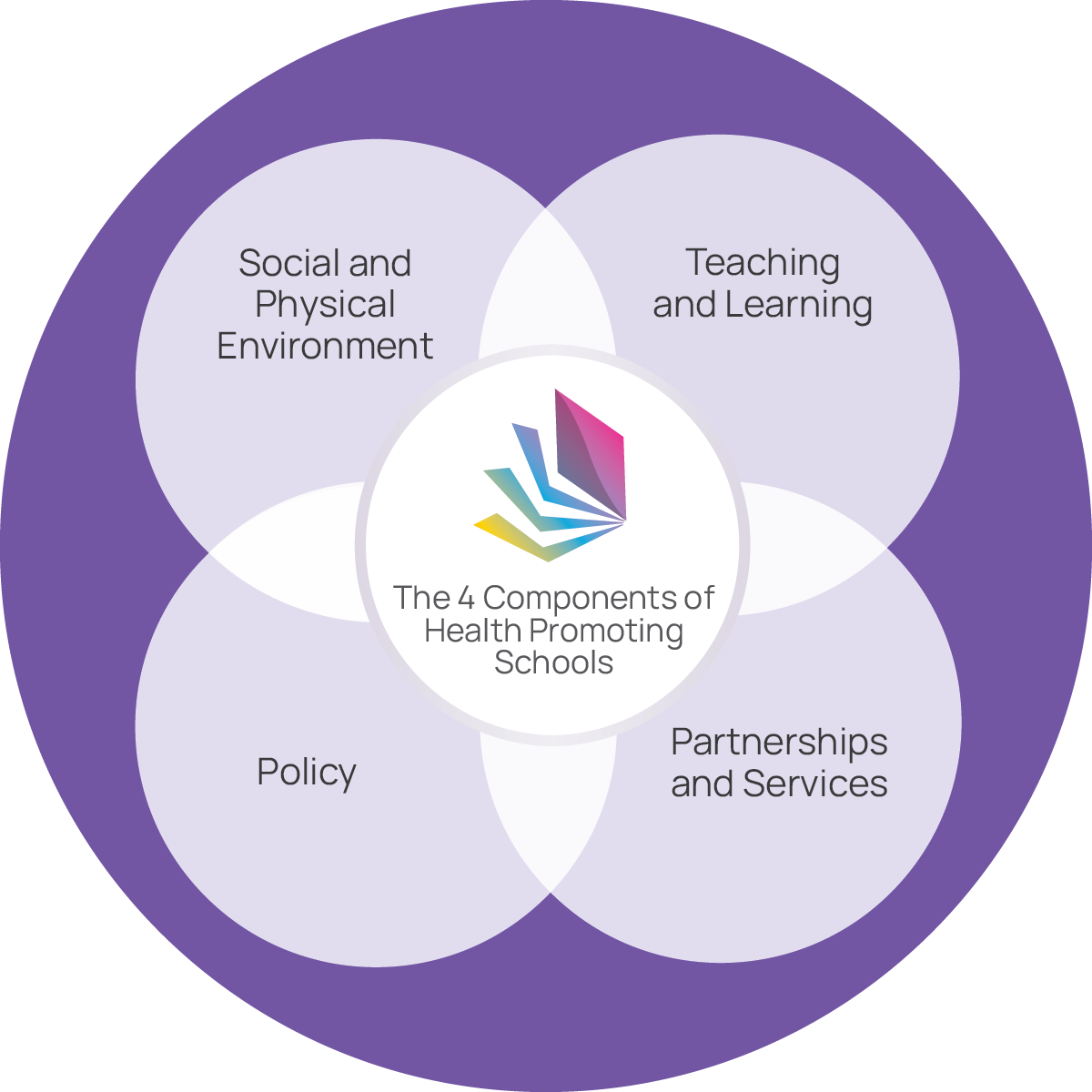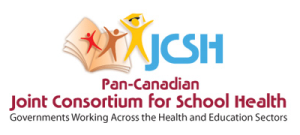Health Promoting Schools is an internationally recognized approach to supporting improvements in students’ educational outcomes while addressing school health in a planned, integrated and holistic way.
What is a Health Promoting Schools approach?
Health Promoting Schools, also known as Comprehensive School Health1, is an internationally recognized approach to supporting improvements in students’ educational outcomes while addressing school health in a planned, integrated, and holistic way.
This whole-school model builds capacity to incorporate well-being as an essential aspect of student achievement. Actions address four distinct but inter-related components that comprise a health promoting schools approach:
- social and physical environment
- teaching and learning
- policy
- partnerships and services.
When actions in all four components are harmonized, students are supported to realize their full potential as learners – and as healthy, productive members of society.
Why do we need Health Promoting Schools?
Health and education are interdependent: healthy students are better learners, and better-educated individuals are healthier. Research has shown that comprehensive school health is an effective way to enhance that linkage, improving both health2 and educational outcomes3 and encouraging healthy behaviours that last a lifetime.
In the classroom, comprehensive school health facilitates improved academic achievement and can lead to fewer behavioural problems4. In the broader school environment, it helps students develop the skills they need to be physically and emotionally healthy for life.
Health Promoting Schools:
- Recognizes that healthy students learn better and achieve more
- Understands that schools can directly influence students’ health and behaviours
- Encourages healthy lifestyle choices, and promotes students’ health and wellbeing
- Incorporates health into all aspects of school and learning
- Links health and education issues and systems
- Needs the participation and support of families and the community at large
Effective, sustainable progress in health promoting schools depends on a common vision, shared responsibilities, and harmonized actions among health, education, and other sectors. The challenge is to coordinate these efforts so that partners pool resources and develop action plans together with, and in support of, schools.
In Canada, the Pan-Canadian Joint Consortium for School Health models, supports, and encourages the partnerships between health and education that are essential to a committed health promoting schools approach.
Different Terminology, Same Ideas
Both comprehensive school health and health promoting schools are widely used in Canada to describe this whole school commitment to the intersection of health and well-being and academic success. In individual provinces and territories in Canada as well as other countries, the approach may be known as one or the other of the above terms, or as healthy schools, or whole child/whole school/whole community. The World Health Organization, together with UNESCO, has developed an implementation document: Make Every School a Health Promoting School (2021). Whatever term is used, the underlying concepts are the same; they are all based on the World Health Organization’s Ottawa Charter for Health Promotion (1986).

The 4 Components of Health Promoting Schools
There are 4 separate but interconnected components that make up health promoting schools. When actions in all four components are harmonized, students are supported to realize their full potential as learners – and as healthy, productive members of society.
Teaching and Learning
Student-centered learning and teacher training through resources, activities, and provincial/territorial curriculum. Students gain age-appropriate knowledge and experiences, helping to build skills to improve their health, well-being, and learning outcomes.
Resources and activities should include school health policies and guidelines, culturally-relevant contexts, and school community assets.
Social and Physical Environment
The social environment is:
- the quality of the relationships among and between staff and students in the school
- the emotional well-being of students
- influenced by relationships with families and the wider community
- Supportive of the school community in making healthy choices by building competence, autonomy, and connectedness.
The school’s social environment supports the school community in making healthy choices by building competence, autonomy, and connectedness.
The physical environment is:
- the buildings, grounds, play space, and equipment in and surrounding the school
- basic amenities such as sanitation, air cleanliness, and healthy foods
- spaces designed to promote student safety and connectedness and minimize injury
- Safe, accessible, and supportive of healthy choices for all members of the school community.
The physical environment is safe and accessible and supports healthy choices for all members of the school community.
Partnerships and Services
Community – and school – based partnerships and services are essential links for student achievement and the health and well-being of everyone in the school community. They enhance the range of supports and opportunities for students, parents, educators, and others. Examples of partnerships and services are:
- health and education sectors working together
- community organizations supporting school activities, student safety, risk interventions, or curriculum
- donations of product or labour from a company towards the creation of a school garden or lunch program
- contracts with fruit and vegetable growers/distributors for school fundraising initiatives.
Policy
The management practices, decision-making processes, rules, procedures, policies, and guidelines at all levels that promote student wellness and achievement, and shape a respectful, welcoming, and caring school environment for all members of the school community.
Health Promoting Schools Core Documents
Provincial Health Promoting Schools/Comprehensive School Health Resources
Footnotes:
1 JCSH formally changed how it refers to this approach in 2023, to Health Promoting Schools, from Comprehensive School Health. It acknowledges that both terms are currently used throughout Canada.
2 Stewart-Brown, S. (2006). What is the evidence on school health promotion in improving health or preventing disease and, specifically, what is the effectiveness of the health promoting schools approach? Copenhagen, WHO Regional Office for Europe (Health Evidence Network report; http://www.euro.who.int/document/e88185.pdf, accessed 16 Sep. 2008).
3 Murray, N.D., Low, B.J., Hollis, C., Cross, A. Davis, S. (2007). Coordinated school health programs and academic achievement: a systematic review of the literature. Journal of School Health, 77 (9), 589-599.
4 IBID
Systems Capacity and Change.
Key Organizational Capacities for Sustaining Comprehensive Approaches to Health Promoting Schools
In recent years, school health proponents, program planners, and policy-makers have recognized the need for a more systematic and policy-oriented approach to health promoting schools.
Although there is little definitive research on effective implementation of a comprehensive integrated school health program, there is considerable evidence supporting the effectiveness of action in specific issue areas. Using a comprehensive approach has the potential to significantly expand on these successes. However, this approach is also complex and difficult to implement and sustain in a meaningful way.
Success rests on sharing a common vision and goals and developing school programs that address the common determinants of health and academic outcomes. Lawrence St. Leger and Don Nutbeam suggest an increasing coincidence of school-related outcomes, school-based intervention, and inputs such as curriculum, professional development, policy, and organizational practices that affect both the education and health outcomes of students5. They provide a map that is useful for joint school health planning and implementation, one where there can be agreement on the actions to take and the reasons for these actions. More recently, St. Leger has discussed the role of Social Emotional Learning in providing a complementary approach to Health Promoting Schools with a distinctly education lens6.
To sustain implementation of comprehensive approaches, many countries and state/provinces are focusing on policy, coordination, and strengthening the organizational capacities of school, public health, and other systems to institutionalize internal and external relationships, responsibilities, and accountabilities for school health promotion. The following key capacities have been identified from a review of several national school health policies, a World Health Organization guide, reviews of literature on interagency coordination, and interview with key informants in several countries.
Key Capacities
Coordinated policies on school health, health issues, and the elements of school health promotion are sometimes played out in local or provincial/territorial interagency agreements that may include financing, administration, and organization. These explicit, comprehensive policy and managerial supports for inter-ministry, interagency, and inter-disciplinary coordination and cooperation should include procedures in policy-making, program planning, and budget preparation to align responses to health and social issues undertaken through and with the school systems. As well, an overarching policy should favour inter-sectoral approaches and it should be reflected in guidance and directives to school, public health, police, social service, and other local authorities and agencies.
Knowledge transfer and exchange within and across systems includes mechanisms and processes to sharing evidence, as well as local solutions and ideas for implementation, funding, and evaluation with decision-makers and practitioners to describe lessons learned and promote promising practices. This would include evidence-based knowledge summaries published by a variety of sources, guidelines for policy, programs and practice from provincial, territorial and professional sources, and tools and models that enable decision-makers and practitioners to reflect on their situation and their practice and to locate materials and models that can be adapted to their circumstance.
Footnotes:
5 Leger, L. S., & Nutbeam, D. (2000). A model for mapping linkages between health and education agencies to improve school health. Journal of School Health, 70(2), 45-50.
6 St. Leger, L., Buijs, G., Keshavarz Mohammadi, N., Lee, A., St. Leger, L., Buijs, G., … & St. Leger, L. (2022). Health-promoting schools. In Handbook of Settings-Based Health Promotion (pp. 105-117). Cham: Springer International Publishing.

